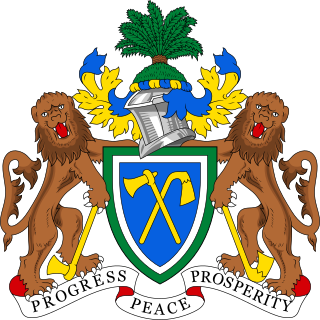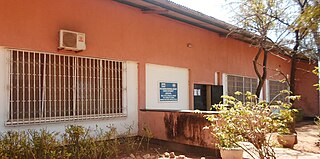Contents
This is a list of museums in the Gambia .
This is a list of museums in the Gambia .

The Gambia, officially the Republic of The Gambia, is a country in West Africa. Geographically, The Gambia is the smallest country in continental Africa; it is surrounded by Senegal on all sides except for the western part, which is bordered by the Atlantic Ocean.

Banjul, officially the City of Banjul, is the capital of The Gambia. It is the centre of the eponymous administrative division which is home to an estimated 400,000 residents, making it The Gambia's largest and most densely populated metropolitan area. The city Banjul is located on St Mary's Island, where the Gambia River enters the Atlantic Ocean.

The Gambia followed a formal policy of non-alignment throughout most of former President Dawda Jawara's tenure. It maintained close relations with the United Kingdom, Senegal, and other African countries. The July 1994 coup strained The Gambia's relationship with Western powers, particularly the United States. Starting in 1995, President Yahya Jammeh established diplomatic relations with several additional countries, including Libya, the Republic of China, and Cuba. As scholars on Gambia's foreign policy have argued, throughout Jammeh's period, the country's foreign policy was a shifting sand, with little of direction.

The president of the Republic of The Gambia is the head of state and head of government of the Gambia. The president leads the executive branch of the government of the Gambia and is the commander-in-chief of the Gambia Armed Forces. The post was created in 1970, when the Gambia became a republic and has been held by three people: Dawda Jawara, who ruled from 1970 until 1994, Yahya Jammeh, who seized power in a bloodless coup that year and Adama Barrow, who defeated Jammeh in elections held in December 2016.

The Gambia national football team represents the Gambia in men's international football and is controlled by the Gambia Football Federation. Until 1965, the team and the country were known as British Gambia. The team has never qualified for the World Cup. In 2021, Gambia qualified for the Africa Cup of Nations finals for the first time in history. The team represents both FIFA and Confederation of African Football (CAF).

Albreda is a historic settlement in the Gambia on the north bank of the Gambia River, variously described as a 'trading post' or a 'slave fort'. It is located near Jufureh in the North Bank Division and an arch stands on the beach connecting the two places. As of 2008, it has an estimated population of 1,776.

The National Assembly of the Gambia is the unicameral legislature of the Gambia. The authorisation for the National Assembly lies in Chapter VII of the Constitution of the Gambia. It is composed of 53 members directly elected through first past the post, and a further five members appointed by the President.

The Prime Minister of The Gambia, known as the Chief Minister from 1961–1962, was the head of government in the Gambia Colony and Protectorate, and later The Gambia, from 1961 to 1970. The position was only held by two people, Pierre Sarr N'Jie and Dawda Jawara.

The Gambian mongoose is a mongoose species native to the Guinean forest-savanna mosaic from Gambia to Nigeria. It is listed as Least Concern on the IUCN Red List since 2008.
The tourism industry today in the Gambia started when a party of 300 Swedish tourists arrived in 1965. That pioneering trip was organised by a Swede named Bertil Harding together with the tour operators Vingresor. It was seen as an ideal place to escape the harsh winter months of Scandinavia where Europeans would enjoy not only sun, sand and beaches but also experience the excitement of a real African holiday. It also offered a new opening for an affordable holiday to increasing numbers of traveling Europeans.

The National Museum of The Gambia is a Gambian cultural museum located in Banjul. It is home to historical documents and displays concerning the History of the Gambia.

Gambian passports are issued to Gambian citizens to travel outside the Gambia.

Gambia National Library Service Authority (GNLSA) is located in Banjul, The Gambia on Reg Pye Lane, the road leading to Tobacco Road. The library was originally operated by the British Council till 1946 and was renamed the National Library of The Gambia in 1971. The National Library was gift from Britain to the people of the Gambia, and was open by his excellency the President Sir Dwada Kariba Jawara in December 1976. The library is maintained and administered by The Gambia National Library Services Authority (GNLSA). As of 2016, the library had a collection of 115,500 books and 85 periodicals. It had more than 42 staff and more than 276 members.

Visitors to the Gambia must obtain a visa from one of the Gambian diplomatic missions, unless they come from one of the visa exempt countries or they do not have a Gambian diplomatic representative/embassy in their country, in this case they can obtain one at the Banjul International Airport.
Henry Anton was a British Army officer and colonial administrator. He served as the Acting Administrator of the Gambia from September 1870 to August 1871.
Time in the Gambia is given by a single time zone, denoted as Greenwich Mean Time. Adopted in 1918, the Gambia has never observed daylight saving time (DST).